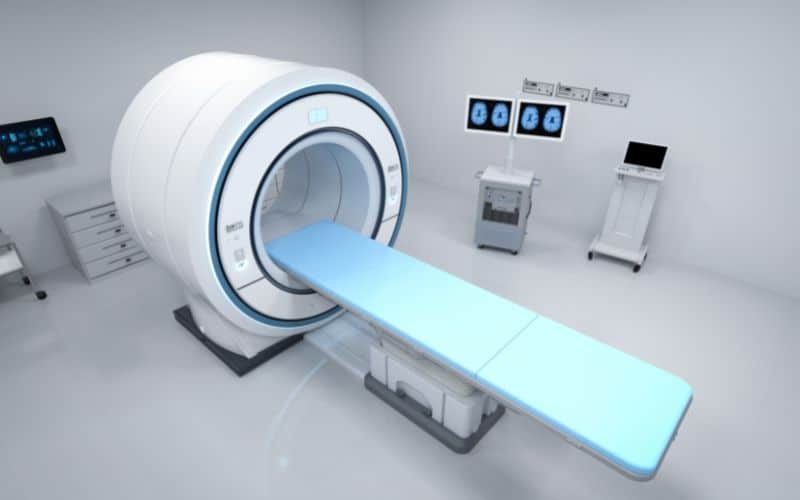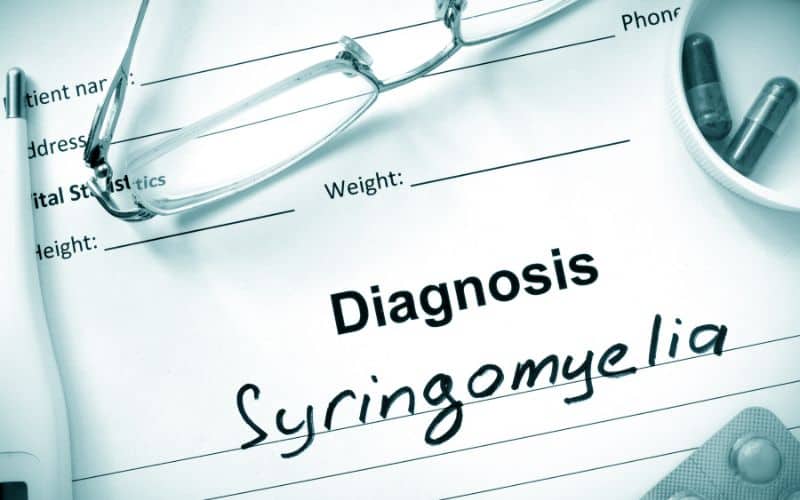Although Cavaliers are well known for their cute looks and adorable expressions, they also have varied health conditions that most folks are unaware of. Almost all Cavalier owners are aware of their problems with their hearts, but Syringomyelia is a disease that seems to slip under the radar, so what is it?
Syringomyelia is a condition that causes fluid-filled pockets to form within the spinal cord; as a result, the cerebrospinal fluid’s abnormal movement causes your Cavalier to experience pain and exhibit unusual behavior.
Research shows that this disease is inherited from their parents and is tied with another disorder called Chiari-like Malformation, or CM for short. But what is Syringomyelia, and what does Chiari-like Malformation have to do with it? Read on to find out more.
What is Syringomyelia (SM)
As the heart pumps blood to the brain to give it fresh oxygenated blood, spinal fluid (known as Cerebrospinal Fluid) flows back and forth from the brain and along the spinal cord with each heartbeat.
As the blood moves into the brain, this fluid transfers from the brain and along the spinal cord and passes through a small hole at the base of the skull (known as the Foramen Magnum) to reach the entire spine.
If the hole in the skull is too small or is blocked in some way, this forces the spinal fluid along the spine at higher pressures, and as a result, it causes the spinal cord to pull apart and makes a cavity known as a Syrinx. This cavity then fills with either fluid from blood vessels and other surrounding tissues or the spinal fluid itself, creating the fluid-filled pocket.
SM is a severe disease that worsens over time, causing extreme pain and discomfort. Although rare in most breeds, it is becoming prevalent among Cavalier King Charles Spaniels.
Spinal trauma or genetic spinal dysplasia can also cause Syringomyelia.
What is Chiari-like Malformation (CM)
Chiari-like Malformation (or CM) is a malformation of the skull found in most brachycephalic dog breeds. (Brachycephalic means short-nosed and refers to dogs with a short muzzle or nose).
Most people know that Cavaliers are brilliant dogs, and to be that intelligent, their brains are more significant (around the same size as a labrador retriever). The brain is overcrowded there because they have small, dome-sized skulls.
As there is no room inside the skull, the brain is squeezed through the small hole in the back of the skull (known as the Foramen Magnum), which prevents the spinal fluid from moving from the brain and along the spinal cord.

Why are CM and SM both seen in Cavaliers?
Chiari-like Malformation is an inherited condition and is believed to be the number one cause of Syringomyelia within Cavaliers. Around 95% of all Cavaliers have Chiari-like Malformation; of those, 50% suffer from Syringomyelia.
CM directly correlates to SM, and studies have found that a more dome-shaped head causes an increased blockage at the Foramen Magnum.
To try and combat the problem, there is a specified breeding protocol to try and prevent cases from worsening in the future and, if at all possible, eradicate these disorders.
Symptoms
Your Cavalier will not show symptoms until at least six months old and sometimes years after birth. The most apparent sign is pain and being extremely sensitive around the head and neck area.
The other signs to watch out for are:
- Barking or crying out when moving position or being picked up
- Scratching their head and neck area
- Not wanting to exercise or walk upstairs
- Changes in behavior, such as being aggressive or very timid
- Not wanting to be touched
The uncontrollable urge to scratch their head and necks is another obvious sign. As they are super sensitive around these areas, the intense scratching is quickly followed by enormous amounts of pain and causes them to yelp out.
As the disorder progresses and the syrinxes become larger (over 0.16″ or 4mm in length), it causes curvature of the spine and forces the poor dog to eat with its head higher than usual. Eventually, as the spinal cord is slowly destroyed, their hind legs weaken, preventing them from walking correctly and, in some extreme cases, causing paralysis.

Similar Disorders
Another disorder called Primary Secretory Otitis Media (PSOM) is suspected to be caused by a dysfunctioning middle ear. The mucus builds up in the middle ear, plugging it and causing the membrane within the ear to bulge.
As the symptoms of Primary Secretory Otitis Media are almost precisely the same as Syringomyelia, it is crucial to get the correct diagnosis from a qualified veterinarian.
Diagnosis
The only way to diagnose Syringomyelia is to perform an MRI (magnetic resonance imaging) scan of your Cavalier.
The veterinarian will need to anesthetize your Cavalier to keep them still during the scan. Once complete, the vet will look for any signs of damage or abnormality along the spine’s length, which may prevent the cerebrospinal fluid from moving freely.
As an MRI scan is very costly, and the symptoms of Syringomyelia are almost the same as Primary Secretory Otitis Media, your vet may want to examine their ears to rule out PSOM.
This will be done using an otoscope to manually look deep into the ear to see any swelling or obstruction. If nothing can be seen with the otoscope, then an x-ray may be necessary.
Treatment
Cavaliers can either show symptoms of CM/SM or no symptoms at all; this is known as asymptomatic. This is important to know, as it affects the treatment of your Cavalier.
There are minimal treatments for CM/SM. Currently, these are drugs to prevent swelling and pain, and also there is the option of surgery. However, if your Cavalier is asymptomatic, they should not be treated with drugs.
Drugs that reduce the production of Cerebrospinal Fluid are used to help with the pain and discomfort, but with some drugs, there can be adverse effects with prolonged use, such as abdominal pain, severe weakness, and lethargy.
Other drugs can be used before the condition worsens, such as Corticosteroids or NSAIDs (Non-Steroidal Anti-Inflammatory Drugs) and Anticonvulsants in more severe cases. However, Corticosteroids have been known to cause side effects such as weight gain, immune suppression, and skin disorders.
Surgery is another option to allow the spinal fluid to flow more freely, but this is costly and should only be performed by specialists.
Breeding
As the old saying goes, ‘Prevention is better than cure.’ So the best way to stamp out this terrible disorder is for breeders to follow the SM breeding protocol and ensure that future Cavaliers do not inherit the disease.
Sources
For more in-depth knowledge of Syringomyelia and Chiari-like Malformation in Cavalier King Charles Spaniels, please refer to the sources of my information.
- Journal of Neurosurgery – Classification of Syringomyelia
- Thieme E-Journals – Neuropediatrics
- Springer Link – Unraveling the riddle of Syringomyelia
- National Library of Medicine – Syringomyelia
- Journal of Neurosurgery – Syringomyelia
- CavalierHealth.org
- National Library of Medicine – Syringomyelia in the Cavalier King Charles spaniel (CKCS) dog


6 thoughts on “Syringomyelia: What is it and Does my Cavalier Have it”